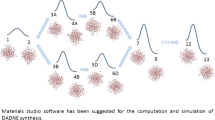Abstract
Quantum chemical theoretical computation was performed on gaseous molecular reaction systems to simulate parallel synthesis of energetic primary explosive precursor 4,6-dinitrobenzofuroxan (4,6-DNBF) and its isomeric derivatives. Related polarized continuum model (PCM) and Materials Studio (MS/forcite) energies were collected via kinetic rate and thermodynamic equilibrium analyses, enabling comparison of and suggestions as to suitable reaction conditions (reaction temperature, reagent concentration, mixed acid ratio) together with feasible pathways to obtain a high production yield of the research target. In summary, at a low reaction temperature of 278 K, 1.0 M 4-nitrobenzofuroxan (or 5,6-nitrobenzofuroxan) could be nitrated using concentrated nitric acid/sulfuric acid at a 1 to 2 volume ratio to efficiently and rapidly produce 4,6-dinitro-benzofuroxan (or 5,6-dinitrobenzofuroxan), in agreement with the experimental results reported in the literature.

Graphical abstract




Similar content being viewed by others
References
Fronabarger JW, Williams MD, Sanborn WB, Parrish DA, Bichay M (2011). Propel Explo Pyrotech 36(5):459
Norris, W. P., US 4529801, 1985
Fronabarger, J. W.; Sitzman, M. E., US 7271267B1, 2007
Ou, J., X. R., Ordnance, 2015, 7,154
Spear RJ, Norris WP (1983). Propel Explo Pyrotech 8(3):85
Wang NX, Li JS (1995). Hecheng Huasue 3(3):260
Wang NX, Li JS, Zhang LX (1995). Hecheng Huasue 3(4):309
Ren ZQ, Yu TY, Xu BY (1995). Energe Mater 3(4):7
Zhang TL, Zhao JT (1996). Jiangsu Chem Indust 24(4):12
Zhou HP, Dong HS, Hao Y (2003). Energe Mater 11(4):236
Nemeikait A, Sarlauskas J, Misevicien L, Anusevicius Z, Marozien A, Cenas N (2004). Acta Bio Polonica 51(4):1081
Li ZX, Tang SQ (2006). China J Energe Mater 14(1):77
Sarlauskas J, Anuseviciusi Z, Misiunas A (2012). Central Europ J Energ Mater 9(4):365
Bowden PR, Tappan BC, Schmitt MM, Lebrun RW, Shorty M, Leonard PW, Lichthardt JP, Francois EG, Hill LG (2018). AIP Confer Proc 1979:100005–100001
Goumont R, Sebban M, Marrot J, Terrier F (2004). Arkovic 3:85
Asghar BH (2019). Arab J Chem 12(8):2476
Li YF, Zhang TL, Zhang JG (2004). Energe Mater 12(4):203
Norris WP (1984) Naval Weapons Center technic report. NWC TP:6522
Li ZX, Tang SQ, Ou YX, Chen BR (2002). Energe Mater 10(2):59
Carvalho PSD, Marostica M, Gambero A, Pedrazzoli Jr J (2010). Eur J Med Chem 45:2489
Chugunova E, Akylbekov N, Shakirova L, Dobrynin A, Syakaev V, Latypov S, Bukharov S, Burilov A (2016). Tetrahedron 7:6415
Hou CY, Chen XF, Liu JY, Lai WP, Wang BZ (2010). Chin J Chem Phys 23(4):387
Simulation software, Accelrys website. (http://accelrys.com/products/collaborative-science/biovia-materials-studio/)
Liu MH, Lin CC (2020) Int J Quant. Chem 120(5):e26117
Liu MH, Liu CW (2017). J Mol Model 23(1):4
Lin, Y. H.; Cheng, K. H.; Li, J. S.; Hwang, C. C.; Yeh, T. F., 28th Symposium of National Defense Technology, 2019, ND28–10810116
Lee C, Yang W, Parr RG (1988). Phys Rev B 37:785
Becke AD (1993). J Chem Phys 98(8):5648
Tomasi J, Mennucci B, Cammi R (2005). Chem Rev 105(8):2999
Laidler KJ, King MC (1983). J Phys Chem 87(15):2657
Laidler, K. J.; Meiser, J. H.; Sanctuary, B.C., Physical chemistry 4th ed. Mifflin, Boston, p 390, 2003
Su, M. D., The chemical kinetics: the concepts and 1000 questions Wu-Nan culture enterprise, Taipei, Taiwan:621–625, 2008
Acknowledgments
The authors would like to thank the National Center for High-Performance Computing for their support in calculations.
Author information
Authors and Affiliations
Corresponding author
Additional information
Publisher’s note
Springer Nature remains neutral with regard to jurisdictional claims in published maps and institutional affiliations.
Rights and permissions
About this article
Cite this article
Liu, YH., Wu, YH., Li, JS. et al. Comparative modeling of improved synthesis of energetic dinitrobenzofuroxan (DNBF) derivatives. J Mol Model 26, 240 (2020). https://doi.org/10.1007/s00894-020-04497-z
Received:
Accepted:
Published:
DOI: https://doi.org/10.1007/s00894-020-04497-z




